Since the red tape and the round seal are heavier than the tacit demand of the Bengali chauvinists, the West Bengal government’s recent initiative to re-establish the status of the Bengali language in its own state by introducing three-language formula at the school level has been hailed by many. It envisages equal emphasis on Bengali, English and the third language.
There is considerable concern over the fact that Bengali is lagging behind in terms of recognition and respect in its homeland… quite unlike the status of other languages in their respective states. By natural right, however, the language of the land should get first priority to be spoken or written ~ a practice that is in vogue not only in India, but in other parts of the world as well.
It has been observed that this language is not the option for the majority; it has also been relegated to the background. The government has responded to the cry.
In retrospect, the teaching of English language in schools was one of the biggest controversies of the Left Front regime. Public opinion had gone against the previous government’s decision to drop English from primary schools, the courts, and government offices.
One could argue that if the Left Front’s linguistic endeavours had taken off successfully in 1977, there would have been no need for such an order on Bengali in 2003. It would perhaps have been appropriate for the Left government to bring about a cultural revolution by enforcing Bengali in all official communications, even if government schools were compelled under pressure of public opinion to teach English from Class III instead of VI. Indeed, its language policy created a privileged class which insisted on English medium in private institutions for its privileged children, while thousands were disadvantaged in government schools.
But the new experiment was carried out in official communication in the multi-lingual society and at a time when a CMDA study revealed that the Bengali-speaking population in Kolkata had come down considerably. All that it did was to vindicate that jobs were available in the mother tongue to justify reintroduction of a ban on English in primary education. Language chauvinism was evident in the renaming of Calcutta and many of its streets.
A part of Curzon Park was renamed as Bhasha Udyan, and Bhasha Dibash is observed on 21 February and 19 May.
The Banga Sanskriti Utsab was revived after a long gap and Banga Sammelans were organised… more to tap the market for nostalgia than open new windows for investment opportunities. But what have those selfprofessed defenders of Bengali actually done for their mother tongue? Those worried about the dwindling importance of the language welcomed the recent decision, although they were not sure whether such a move at the government level would help the language regain its past glory.
In gross violation of the guidelines of the three-language formula put forth by the Bhasha Commission in the 1960s, it has been observed that there are many Hindimedium schools in Kolkata where Bengali is not taught. Also, many Englishmedium schools don’t have a Bengali language teacher. True, we have state-controlled organisations for promoting the language through books, films, theatre and the other art forms, but can we take it for granted that they are used properly?
Is the Bangla Academy always devoted to promotion of the best of Bengali literature making it a valuable reference point for scholars and researchers?
Has the Kolkata Book Fair proved itself to become a big platform for quality Bengali literature to crop up? Well, we are proud of some of India’s finest talent in the traditional forms of music and theatre, but can we readily mention the number of plays by Sambhu Mitra or Ajitesh Bandopadhyay, published by the West Bengal Natya Academy? The activities of the State Music Academy are seldom extended to old lyricists and composers, the folk forms and musical styles.
The fact of the matter is that not much has been done to promote the Bengali language except for some cosmetic changes from time to time. The majority of Bengali youth, graduating from our universities year after year, cannot write correct Bengali.
Their vernacular proficiency is simply atrocious. The 50-mark vernacular paper at the college level is a joke. The neglect of the language is apparent in answer papers written in Bengali. They bristle with wrong spellings and grammatical and syntactical errors. The crisis is most acute in the humanities stream which demands clarity of thought and expression. The Ashok Mitra Commission had observed that two languages at the primary level exerted a heavy pressure on a child. The mother tongue, it was noted, would be learnt better.
The Commission recommended the introduction of the English language in Class V. A massive signature campaign by the Save Education Committee and a Bangla Bandh by SUCI followed. Later, the Pabitra Sarkar Committee recommended that English be taught after the second semester of Class II. Without doubt, there is substance in the cavil of many Bengali chauvinists, specifically that Bengali culture is in jeopardy. There is a marked tendency in middle class Bengali families to send their children to English medium schools.
Fearing that “the existence of Bangla is threatened”, the Bhasha Sahid Smarak Samiti was formed to revitalise the Bengali language and culture. Linguistic identity is an important issue and Bengalis have time and again reacted sharply to threats to their linguistic identity. In 1961, 11 Bengalis died in Assam while fighting for their mother tongue. In fact, Bengalis in Assam have long been struggling to resist the compulsion to study Assamese at the school level. Bengali is the national and official language of Bangladesh.
Apart from West Bengal, it is the principal state language of Tripura and Assam. The struggle for freedom and democracy in Bangladesh was embedded in a movement for the right to use the mother tongue. Bengalis outside Bengal have also contributed to the development of the language and its literature. Barak Valley in Assam has produced several Bengali poets, playwrights and novelists, notably Saktipada Brahmachari, Udayan Ghosh, Britijpada Bhattacharya and Biman Chowdhuri.
The deterioration in Bengali studies in West Bengal accentuated after the collapse of the mother-tongue medium school system since the time of Iswarchandra Vidyasagar, who, in the process of developing the Bengali language, promoted English and Sanskrit studies too. But unfortunately, the middle class no longer prefers such schools, perhaps because English is no longer taught in these institutions.
Parents send their children to English-medium schools because the importance of English in today’s society is unquestionable. It is imperative to set up good Bengali-medium schools which can produce students who are equally proficient in English.
Bengali culture will then be able to countenance the information age. In Europe today, students, especially those from Germany, the Netherlands and the Scandinavian countries, are as fluent in English as their counterparts in Britain. Yet their medium of instruction in schools is their mother tongue.
Could we imagine a Chaitanya, or Sri Ramakrishna or Sri Swami Vivekananda fighting to promote the Bengali language? People of other states picked up Bengali to read Sri Ramakrishna, Bankimchandra,Vivekananda and Rabindranath Tagore.
The English writings of Vivekananda and Sri Aurobindo were meant to bridge the gap between European and Bengali cultures.
The writer is a former Associate Professor, Dept. of English, Gurudas College, Kolkata.











